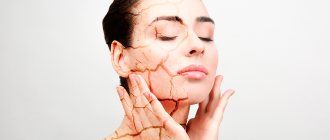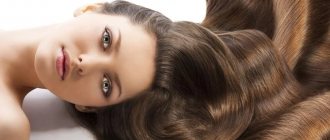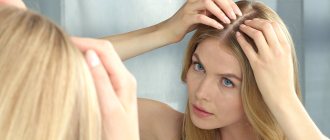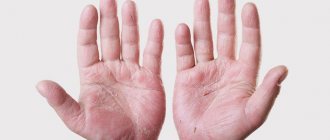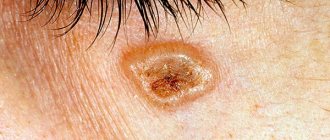If your head of beautiful hair gradually begins to lose its shine and fall out, and your skin is unbearably itchy and flaky, you should pay special attention to it. There is a possibility of developing a fungal infection on the scalp. The causative agents of this disease are various types of fungus. The disease brings a lot of unpleasant sensations and threatens with dangerous consequences. But do not despair, modern medicine can cope with this disease.
Causes of fungus on the head
The occurrence of a fungal infection on the head can be caused by various reasons.
Mycosis of the skin is provoked by:
- contact with an infected person or animal;
- failure in the body's hormonal system;
- nutritional disorders that contribute to a decrease in the amount of vitamins and proteins - if there is a lack of them in the body, fungi develop very quickly;
- failure of the endocrine system;
- cancer;
- increased sweating;
- blood diseases.
External factors can also trigger the appearance of fungus on the head:
- overheating and dehydration of the body;
- bad ecology;
- failure to comply with basic rules of personal hygiene;
- abuse of ultraviolet radiation;
- frequent stress and depression.
Seborrheic eczema
The disease primarily affects the scalp, but the ears, chest, and shoulder blades can also be affected.
Outwardly it looks like red plaques with small yellowish or red pimples on the head. Gradually, the spots can connect, forming brown redness in the shape of a wave. In severe cases, painful wounds form due to trauma to the skin. Unfavorable factors contribute to the occurrence of eczema:
- poor nutrition;
- alcohol abuse;
- exposure to chemicals;
- thermal burns;
- active proliferation of fungal microflora.
Eczema most often occurs in people with a family history of a similar disease.
Treatment of the scalp is quite lengthy and is accompanied by the use of medications that help eliminate the lesions.
Classification of fungal infections and their symptoms
Mycoses (skin lesions) are divided into three groups:
- Trichophytosis (ringworm).
- Microsporia.
- Favus (Scab).
Trichophytosis
Belongs to a group of serious diseases caused by the fungus Trichophyton. A patient with this disease is at risk of extensive hair loss with the formation of large bald patches. Such a patient is very contagious, and upon contact with him, the likelihood of infection is very high.
Superficial form of trichophytosis
Ringworm has three forms of development: superficial, chronic and infiltrative-suppurative (deep).
- The superficial form of trichophytosis is expressed by the manifestation of symptoms on the 5-8th day of infection. Spots no larger than 2 cm in size are visible on the scalp. The hair in these places begins to thin and the lesions become covered with a gray crust. The affected areas cause severe itching, and when scratched, red sores appear. Over time, redness and swelling increase, ulcers and crusts appear. In focal areas, hair changes its color, shine and elasticity.
- Chronic trichophytosis develops in an unnoticeable form for the patient. It begins mainly on the head, from where the inflammation spreads to the smooth skin. Chronic trichophytosis is localized on the temples and back of the head in the form of small, fuzzy, scaly spots. Basically, it is a consequence of untreated superficial trichophytosis. Chronic trichophytosis is usually called “black dot”, since black dots can be one of the distinctive signs of the disease.
- Infiltrative-suppurative (deep) form of ringworm. The manifestation of the disease begins with small spots of a pinkish tint, along the edges of which there are clearly defined boundaries. Over time, the affected areas of the skin increase in size and rise significantly above the skin level, and a strong inflammatory process begins. When connected to each other, the spots form figures of unusual shape, covered with ulcers and flaky crusts. The hairs begin to partially fall out. A characteristic feature of this form is inflamed hair follicles filled with pus, which, when pressed, release copious fluid. With inflammation, the lymph nodes become enlarged, and malaise is noted, accompanied by fever and headache.
Infiltrative suppurative form of ringworm
Microsporia
The second group of varieties of mycosis. Most often, this disease occurs in children, so all family members are at risk. Microsporia leads among fungal infections in terms of speed of spread. The symptoms of microsporia are similar to other infectious diseases of the head, so the type of fungal disease can be recognized only after examination.
Symptoms of microsporia include:
- The affected areas are concentrated mainly on the crown, temporal and parietal parts of the head.
- Foci of microsporia are approximately 2 to 6 cm in size, round in shape and clearly defined.
- At the beginning of inflammation, the fungus is located at the root of the hair follicle. As the disease progresses, you can see a white ring surrounding the hair in the form of a cuff.
- After a week, the fungus spreads throughout the hair, causing it to become brittle.
- Stumps remain in this place, which, when stroked, tilt to one side.
With advanced microsporia, lesions appear on the head in the form of tumors with red edges.
Favus Scab
Favus
The third group of fungus is on the head. A characteristic feature of Scab is the presence of crusts on the head, within which hair can grow. If treatment is not started in time, the fungus quickly spreads throughout the entire scalp. After the disease, the skin atrophies, and complete baldness occurs in those places where the inflammatory process lasted for a long time. Patients with Scab are constantly bothered by itching, heaviness due to the accumulation of keratinized crusts and unpleasant sensations from hair sticking together.
Seborrhea
The cause of this disease is a malfunction of the sebaceous glands on the head.
Dandruff appears, the scalp peels due to insufficient oil secretion through the pores or oily secretions, acne - due to excess.
Types of seborrhea:
- fat;
- dry;
- combined.
Most often it occurs during adolescence in girls. The causes of dry seborrhea can be a decrease in the body's immune functions, neuroses, poor nutrition, and hormonal changes.
Prolonged oily seborrhea in men can result in baldness. The source of pathology is often an increase in the level of androgens and, as a result, an increase in the secretion of fat from the sebaceous glands. Women also develop seborrhea due to changes in the balance of androgens, progesterone and estrogens.
In addition to the listed reasons, seborrhea can lead to:
- Parkinson's and Itsenko-Cushing's disease;
- psychosis, epilepsy;
- lack of biotin (vitamin H);
- abuse of anabolic steroids;
- sleeping sickness;
- long-term use of glucocorticosteroids.
The difference between seborrhea and seborrheic dermatitis lies in the very cause of the pathology. Dermatitis is caused by yeast-like fungi.
Normally, everyone has them, but any negative factors lead to the active proliferation of fungi, which becomes the cause of the disease.
What measures need to be taken:
- consult a dermatologist;
- pass the necessary tests to make a diagnosis (blood for biochemistry and hormones, skin scraping);
- if there is a suspicion of hormonal disorders, an ultrasound examination of the thyroid gland should be performed.
After diagnosis, the patient is prescribed medications to combat the causes of the disease: antifungal drugs, selenium and sulfur compounds, vitamins and others.
Differential diagnosis of fungus on the head
After the initial examination of the patient, the attending physician determines the degree of damage to the scalp. The most effective way to ensure correct results is to scrape the scalp to check for fungal infection. However, there may be some obstacles to making an accurate diagnosis.
The method of differential diagnosis is necessary in order to exclude diseases that are not suitable for some symptoms or signs and to find the only possible disease.
Head fungus should be distinguished from the following pathologies:
- Alopecia areata is a disease characterized by hair loss and the formation of round bald patches of varying sizes on the skin. With complications, it can be total and spread throughout the body. At the initial stage, the blood vessels supplying the hair follicles close due to the proliferation of tissue, most often connective tissue. The hair growth cycle is disrupted and the hair shafts break off. The localization of areas of skin not covered with hairs depends on the form of alopecia: in some cases, only the area of the back of the head and temples can go bald, in others - eyebrows, eyelashes and even the entire scalp.
- A bacterial abscess is a purulent inflammation, which is accompanied by the appearance of cavities filled with purulent exudate. Superficial symptoms include redness of the affected areas of the skin, increased sensitivity and soreness, as well as swelling. All this is accompanied by general malaise, weakness and fatigue. When the abscess spreads to the brain, intracranial pressure increases, coordination of movements is impaired, and hallucinations are possible.
- Trichotillomania is a disease that occurs due to stress or disorders of the nervous system. Manifests itself in the pulling out of hair on the head or other parts of the body. May occur in conjunction with compulsive hair eating (trichophagia). The skin at the site of baldness is healthy without itching or discomfort. Pulling out hair brings pleasure and relief to the patient.
- Seborrheic dermatitis is a disease caused by a disorder of sebum production. With pathology, the secretion of sebum by the holocrine glands increases and the chemical composition of the fatty secretion changes. Most often occurs in the occipital-parietal region of the head. The affected areas experience peeling, redness and itching. May spread to the bridge of the nose, eyebrows and nasolabial folds. The causes of the development of the disease are often associated with hormonal, genetic or nervous disorders, as well as improper use of personal hygiene products. Baldness does not usually occur.
- Folliculitis is a lesion of the hair follicle of an infectious nature, which leads to purulent formations. In places where hair grows, pustules appear, after opening which ulcers form. After healing, the skin becomes scarred, and deep damage to the scalp tissue negatively affects the condition of the hair.
Treatment and prevention
Treatment for hair diseases depends on the specific type of disease. Fungal processes require the use of local and systemic antimycotics. If the pathology is caused by an infection, then antibiotics are prescribed.
Genetic abnormalities of hair follicles are practically untreatable. Many hair diseases are associated with abnormalities in the functioning of internal organs. To identify the cause, you need to undergo an examination.
To prevent diseases of the scalp and hair you need:
- protect them from exposure to direct ultraviolet rays and low temperatures;
- use detergents suitable for a specific hair type;
- choose quality hair care products;
- use personal hygiene products (comb, towel) to avoid contracting a fungal or infectious disease;
- eat properly and rationally, deficiency of vitamins and microelements affects the condition of the hair;
- Avoid washing your hair with hot water;
- abandon the hair dryer in favor of natural drying;
- Avoid frequent styling using devices that expose hair to high temperatures.
Head fungus in children
Both children and adults are equally susceptible to fungal diseases. In the initial stages, a single focus of infection appears. After suppuration, the disease intensifies and the number of formations on the skin increases.
Very often, the cause of fungus on the head in children can be interaction with infected animals. Parasitic fungi can also enter the body through contact with children or playing outside. Any personal hygiene item, clothing and underwear are potential sources of fungus. Infection is especially dangerous in a hairdressing salon where untreated and undisinfected tools are used.
One of the hallmark symptoms of fungal infection in children is enlargement of regional lymph nodes. Each of these groups serves as a kind of protection for a certain part of the human body. Biological poisons of mushrooms, after entering the body, significantly affect it and worsen the general state of health. Rashes may appear, as in allergic reactions or viral diseases. After the patient’s condition improves and is cured, scar tissue appears at the site of the fungal lesions.
Young children with weakened immune systems are most susceptible to harmful microorganisms entering the body, the most common of which are dermatophytes. Children complain of rash, burning and itching of the skin.
Types of scalp diseases
Skin diseases on the head under the hair can be divided into:
- fungal;
- dermatological;
- infectious;
- allergic.
The symptoms of each type of disease are very similar. In all cases, a person feels itching and peeling of the skin often occurs. Of course, there are individual signs of each disease.
What diseases cause hair loss? This can happen with absolutely any type of scalp ailment. Typically, hair loss occurs during a long-term illness, and if you don’t really take care of treatment. If you start doing something in time, you can save your hair and your well-being.
Similar photos on: microbak.ru
Drug therapy
Systemic medications with antifungal properties are most effective. Unlike local remedies, they are active throughout the body. An important disadvantage of such drugs is their high level of toxicity, which can affect the functioning of various organs and systems. They should not be taken by people with kidney disease, cancer, anemia, metabolic disorders, or pathologies of the cardiovascular system.
When treating fungus on the head, the following are popular:
- Miconazole is a drug in the form of an ointment that is used to treat both fungus and dermatophytes, external forms of candidiasis.
- Clotrimazole is a synthetic drug with an antifungal effect; used for various mycoses.
- Griseofulvin - antifungal tablets for systemic use; the drug stops the division of fungal cells;
- Keratolytic ointments and tablets - soften and reject the hypertrophied layer of the epidermis;
- balms and antifungal shampoos.
This treatment lasts more than a month. In case of complications or severe cases, hormonal therapy and antibiotics may be prescribed.
Diagnostics
If you suspect the development of a fungus on the scalp, a diagnosis of the problem area is required. Research allows us to identify the disease and select optimal treatment methods to eliminate it.
The fungus can be detected on the head using a Wood's lamp. A visual inspection of the problem area is also required. The doctor must assess the current condition of the skin and hair, check for peeling and inflammation of the epidermis.
It is mandatory to take a scraping from the affected area for laboratory analysis. It allows you to identify the causative agent of the disease.
Traditional medicine recipes
In some cases, traditional medicine recipes also produce a positive effect. In the initial stages of fungus or mild forms, eucalyptus oil will help. A small amount should be applied to hair using a comb, without touching damaged areas.
Garlic has proven itself as a means of combating fungal infections. To prepare the mixture you need garlic juice, almond or olive oil. If desired, you can add citrus juice (lemon). Rub the resulting product into the scalp with gentle movements, and after an hour, wash well. Do this procedure before every shampoo. Blood circulation improves and hair becomes stronger. The only thing that bothers me is the specific smell of garlic.
To get rid of scales, you need to pour 1 tablespoon of tansy with boiling water (0.5 l) and leave for two hours. Wash for 4 weeks. For the same purpose, use a decoction of lemon peel (cook for 15 minutes over low heat).
Symptoms
Since the symptoms of the disease are different, the doctor selects individual treatment for each patient.
Excessive flaking of the scalp is the initial symptom of mycosis
There are varieties of fungus, the treatment of which requires the selection of specific therapy. But in general, general symptoms of infection have been identified that indicate the presence of a disease in a person:
- Hair becomes dry, dull, and begins to fall out profusely.
- The scalp begins to peel.
- Flaky areas appear that have a rounded shape and unclear contours.
- Pink plaques begin to appear on the scalp, slightly rising above the surface.
- If your hair falls out a lot, you may experience a receding hairline.
- Over time, blisters appear on the plaques, which are covered with yellow or gray crusts.
- Black dots appear at the base of the hair follicle.
- Purulent skin lesions appear.
- A person develops a large amount of dandruff.
- Presence of an allergic rash.
